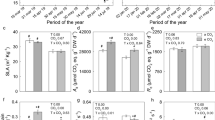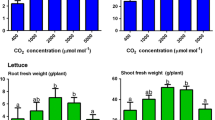Abstract
The global average temperature has witnessed a steady increase during the second half of the twentieth century and the trend is continuing. Carbon dioxide, a major green house gas is piling up in the atmosphere and besides causing global warming, is expected to alter the physico-chemical composition of plants. The objective of this work was to evaluate the hypothesis that increased CO2 in the air is causing undesirable changes in the nutritional composition of tomato fruits. Two varieties of tomato (Lycopersicon esculentum) were grown in ambient (400 μmol mol−1) and elevated (1,000 μmol mol−1) concentration of CO2 under controlled conditions. The fruits were harvested at premature and fully matured stages and analyzed for yield, proximate composition, elemental concentration, fatty acid, and vitamin C contents. The amount of carbohydrates increased significantly under the enhanced CO2 conditions. The amount of crude protein and vitamin C, two important nutritional parameters, decreased substantially. Fatty acid content showed a mild decrease with a slight increase in crude fiber. Understandably, the effect of enhanced atmospheric CO2 was more pronounced at the fully matured stage. Mineral contents of the fruit samples changed in an irregular fashion. Tomato fruit has been traditionally a source of vitamin C, under the experimental conditions, a negative impact of enhanced CO2 on this source of vitamin C was observed. The nutritional quality of both varieties of tomato has altered under the CO2 enriched atmosphere.
Similar content being viewed by others
References
Ainsworth, E. A., & Long, S. P. (2005). What have we learned from 15 years of free-air CO2 enrichment (FACE)? A meta-analytic review of the responses of photosynthesis, canopy properties and plant production to rising CO2. New Phytologist, 165, 351–372.
Allen, S. E., Grimsha, H. M., & Rowland, A. P. (1986). Chemical Analysis. In P. D. Moore & S. B. Chapman (Eds.), Methods in plant ecology (pp. 285–344). Oxford, London: Blackwell.
Allen, L. H., Jr., Kirkham, M. B., Olszyk, D. M., & Whitman, C. E. (1997). Advances in carbon dioxide research (p. 228). Madison, WI: ASA Special Publication 61.
AOAC. (2000). Official methods of analysis (17th ed.). Washington, DC: Association of Official Analytical Chemists.
Conroy, J. P. (1992). Influence of elevated atmospheric CO2 concentrations on plant nutrition. Australian Journal of Botany, 40, 445–456.
Cure, J. D., & Acock, B. (1986). Crop responses to carbon dioxide doubling: A literature survey. Agricultural and Forest Meteorology, 38, 127–145.
DaMatta, F. M., Grandis, A., Arenque, B. C., & Buckeridge, M. S. (2010). Impacts of climate changes on crop physiology and food quality. Food Research International, 43, 1814–1823.
Gifford, R. M., Barrett, D. J., & Lutze, J. L. (2000). The effects of elevated [CO2] on the C:N and C:P mass ratios of plant tissues. Plant and Soil, 224, 1–14.
Guil-Guerrero, J. L., & Rebolloso-Fuentes, M. M. (2009). Nutrient composition and antioxidant activity of eight tomato (Lycopersicon esculentum) varieties. Journal of Food Composition and Analysis, 22, 123–129.
Högy, P., & Fangmeier, A. (2009). Atmospheric CO2 enrichment affects potatoes: 2. Tuber quality traits. European Journal of Agronomy, 30(2), 85–94.
Idso, S. B., & Idso, K. E. (2001). Effects of atmospheric CO2 enrichment on plant constituents related to animal and human health. Environmental and Experimental Botany, 45, 179–199.
IPCC. (2007). Climate Change 2007: impacts, adaptation and vulnerability. Contribution of Working Group I to the Fourth Assessment Report of the Intergovernmental Panel on Climate Change. Cambridge: Cambridge University Press.
Islam, M. S., Matsui, T., & Yoshida, Y. (1996). Effect of carbon dioxide enrichment on physico-chemical and enzymatic changes in tomato fruits at various stages of maturity. Scientia Horticulturae, 65, 137–149.
Keeling, R. F., Piper, S. C., Bollenbacher, A. F., & Walker, J. S. (2008). Carbon Dioxide Research Group, Scripts Institution of Oceanography. California: University of California.
Kimball, B. A., Kobayashi, K., & Bindi, M. (2002). Responses of agricultural crops to free-air CO2 enrichment. Advances in Agronomy, 77, 293–368.
Li, J., Zhou, J., & Duan, Z. Q. (2007a). Effects of elevated CO2 concentration on growth and water usage of tomato seedlings under different ammonium/nitrate ratios. Journal of Environmental Sciences, 19, 1100–1107.
Li, J., Zhou, J., Duan, Z. Q., Du, C. W., & Wang, H. Y. (2007b). Effect of CO2 enrichment on the growth and nutrient uptake of tomato seedlings. Pedosphere, 17(3), 343–351.
Lincoln, D. E., Fajer, E. D., & Johnson, R. H. (1993). Plant insect herbivore interactions in elevated CO2 environments. Trends in Ecology & Evolution, 8, 64–68.
Loladze, I. (2002). Rising atmospheric CO2 and human nutrition: Toward globally imbalanced plant stoichiometry. Trends in Ecology & Evolution, 17(10), 457–461.
Nilsen, S., Hovland, K., Dons, C., & Sletten, S. P. (1983). Effect of CO2 enrichment on photosynthesis, growth and yield of tomato. Scientia Horticulturae, 20, 1–14.
Olszyk, D. M., & Wise, C. (1997). Interactive effects of elevated CO2 and O3 on rice and flacca tomato. Agriculture, Ecosystems and Environment, 66, 1–10.
Overdieck, D. (1993). Elevated CO2 and the mineral content of herbaceous and woody plants. Vegetatio, 104–105(1), 403–411.
Reinert, R. A., Eason, G., & Barton, J. (1997). Growth and fruiting of tomato as influenced by elevated carbon dioxide and ozone. New Phytologist, 137, 411–420.
Suárez, M. H., Rodríguez, E. M., & Romero, C. D. (2008). Chemical composition of tomato (Lycopersicon esculentum) from Tenerife, the Canary Islands. Food Chemistry, 106, 1046–1056.
Thongbai, P., Kozai, T., & Ohyama, K. (2010). CO2 and air circulation effects on photosynthesis and transpiration of tomato seedlings. Scientia Horticulturae, 126, 338–344.
Thybo, A. K., Edelenbos, M., Christensen, L. P., Sørensen, J. N., & Thorup-Kristensen, K. (2006). Effect of organic growing systems on sensory quality and chemical composition of tomatoes. LWT- Food Science and Technology, 39, 835–843.
Wheeler, R. M., Mackowiak, C. L., Stutte, G. W., Yorio, N. C., & Berry, W. L. (1997). Effect of elevated carbon dioxide on nutritional quality of tomato. Advances in Space Research, 20, 1975–1978.
Wittwer, S. H. (1995). Food, climate, and carbon dioxide: The global environment and world food production. Boca Raton, FL: Lewis Publishers/CRC Press.
Wu, W. H., Lu, J. Y., Jones, A. R., Mortley, D. G., Loretan, P. A., Bonsi, C. K., et al. (1997). Proximate composition, amino acid profile, fatty acid composition, and mineral content of peanut seeds hydroponically grown at elevated CO2 levels. Journal of Agricultural and Food Chemistry, 45, 3863–3866.
Author information
Authors and Affiliations
Corresponding author
Rights and permissions
About this article
Cite this article
Khan, I., Azam, A. & Mahmood, A. The impact of enhanced atmospheric carbon dioxide on yield, proximate composition, elemental concentration, fatty acid and vitamin C contents of tomato (Lycopersicon esculentum). Environ Monit Assess 185, 205–214 (2013). https://doi.org/10.1007/s10661-012-2544-x
Received:
Accepted:
Published:
Issue Date:
DOI: https://doi.org/10.1007/s10661-012-2544-x




